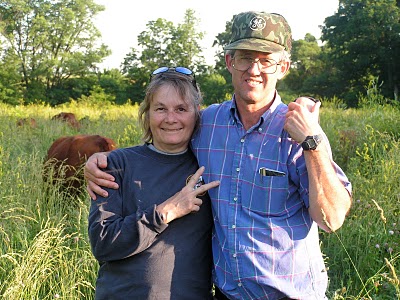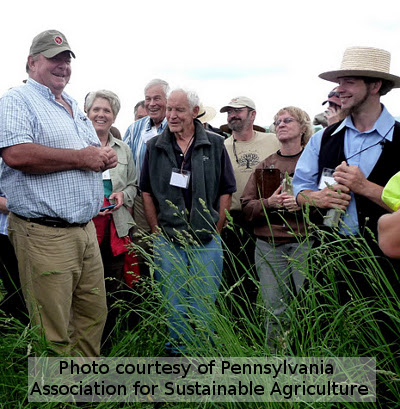
Greg Judy on mob grazing
 A
couple of months ago, I attended an all day workshop about mob grazing
led by Greg Judy. He was a riveting, entertaining, and down to
earth speaker, but the information he covered was even better than the
presenting style.
A
couple of months ago, I attended an all day workshop about mob grazing
led by Greg Judy. He was a riveting, entertaining, and down to
earth speaker, but the information he covered was even better than the
presenting style.
Greg and his wife
started farming in the late 1980s on poor "grazing land" in
Missouri. "All I knew was: cows
eat grass," Greg explained. Initially, he ran his cattle using
conventional methods --- letting them eat the same pasture continuously
--- but eventually he switched over to management
intensive grazing.
Under the management
intensive system, Greg focused on keeping seed
heads from forming on his grass. The mandatory fast
spring rotations to prevent the grass from going to seed seemed to work
at first, but the pasture suffered in July. During the summer
slump, grass didn't grow at all, and he had to feed hay or sell animals.
 Enter Ian Mitchell-Innes, a
South African farmer practicing mob grazing. Over the last
decade, Ian had increased the fertility of his farm so much that he was
able to quadruple his stocking rate, and Greg became his willing
pupil. Greg learned to let grass grow taller in the spring, then
noticed that the unstressed plants no longer obsessed over reproducing,
instead growing more green leaves and longer roots. Three years
later, Greg was able to quit his job and become a full time rancher.
Enter Ian Mitchell-Innes, a
South African farmer practicing mob grazing. Over the last
decade, Ian had increased the fertility of his farm so much that he was
able to quadruple his stocking rate, and Greg became his willing
pupil. Greg learned to let grass grow taller in the spring, then
noticed that the unstressed plants no longer obsessed over reproducing,
instead growing more green leaves and longer roots. Three years
later, Greg was able to quit his job and become a full time rancher.
Today, he pastures his
animals on twelve farms, focusing on grazing livestock and building
topsoil. "We like to think of ourselves as microbe farmers," Greg
explained, going on to note that they are marketers of solar energy ---
the only free resource on the farm. Greg adds no lime or chemical
fertilizers to his soil, has no machinery, and uses minimal labor.
This week (and next),
I'll cover Greg's system in depth, but for now, I'll leave you with
some outside the box ways he suggests making your farm pay for
itself. He highly recommends leasing for young farmers who don't
have the cash to buy the land outright, noting that he has free
lifetime leases on several plots of hunting land, having proven to the
owners that they'll harvest more deer due to his management. And
although he makes a lot of his livelihood from the beef he raises, Greg
notes that the parasite resistant sheep he sells as breeding stock are
the highest profit item on his farm. Finally, he tosses out other
ideas that are compatible with the ranching lifestyle --- attracting
ecotourists interested in birding or wildlife watching, adding nature
trails, or leasing out the pasture to hunters. His message is
clear --- if you get creative and nurture the land, you can make a
living on the farm.
 This post is part of our Mob Grazing lunchtime series.
Read all of the entries: This post is part of our Mob Grazing lunchtime series.
Read all of the entries:
|
Want more in-depth information? Browse through our books.
Or explore more posts by date or by subject.
About us: Anna Hess and Mark Hamilton spent over a decade living self-sufficiently in the mountains of Virginia before moving north to start over from scratch in the foothills of Ohio. They've experimented with permaculture, no-till gardening, trailersteading, home-based microbusinesses and much more, writing about their adventures in both blogs and books.
Want to be notified when new comments are posted on this page? Click on the RSS button after you add a comment to subscribe to the comment feed, or simply check the box beside "email replies to me" while writing your comment.
